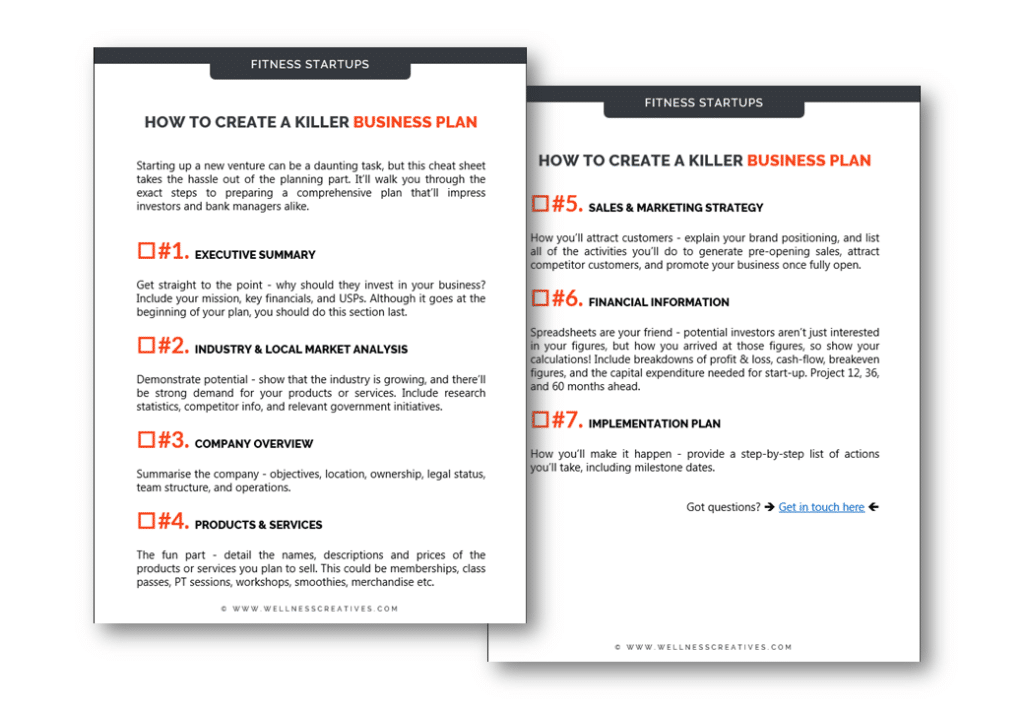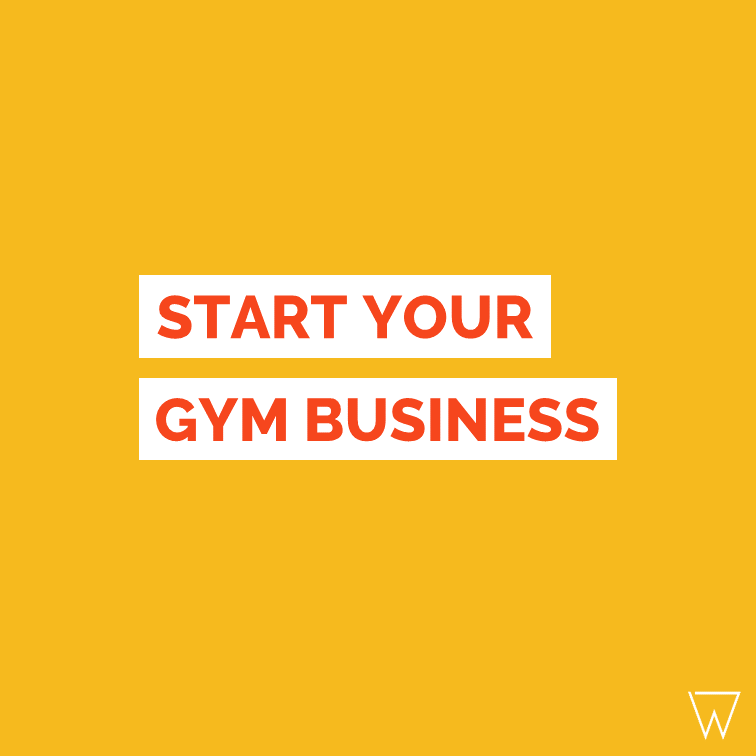Want to know how to start a gym business? Perhaps you’ve always loved fitness and want to start your own studio, or worked in the industry for years and it’s time to become your own boss. Whatever your reason for starting a gym, we’ve got you covered.
In this article – learn how to start a successful gym in 7 steps, including business planning, securing funding, and pre-launch marketing.
We’ve helped several new gyms and fitness studios to launch their businesses, so we know exactly what’s involved. Having worked in the fitness industry for 15+ years, we understand the operational, marketing, and financial aspects to setting up a successful business. So, you can shortcut the learning curve and benefit from our expertise in this guide…
How To Start a Gym or Fitness Studio – Overview
Here’s an overview of the seven steps towards opening a gym or fitness studio…
- Define your idea
- Create a plan
- Secure funding
- Find a location
- Set up your gym
- Launch
- Grow your business
Let’s dive into each of these start-up steps in more detail…

Fitness Marketing Ideas Ebook
80+ fitness marketing ideas for your gym, studio, or online business. Attract new members, get more PT clients & boost your fitness blog.
#1 – Define Your Gym Business Idea
The very first step is to define the business idea for your gym, fitness studio, or health club. What’s the concept? Who is it aimed at?
For some people, this will come easily. They may have had a great fitness-themed business idea for a long time but only just decided to give it a go. But for others, this initial part can be tough.
Perhaps you’re keen to start a fitness business but aren’t sure what kind of venture to go for. Or you want to look at all the options before making a decision. If so, then here is a list of gym business ideas that you can consider…
- Classic gym or fitness centre
- Boutique fitness studio
- Gym franchise (Anytime Fitness, Snap, Orange Theory, etc.)
- Yoga or Pilates studio
- Personal training studio
- CrossFit box
- Health club
- Online fitness training business
- Or you can start a business related to gyms, like a fitness equipment or accessories distributor, workout clothing brand, mobile personal training business, or fitness supplement manufacturer.
At this stage, it’s also important to think about what will make your fitness club different from others in the local area. Will you be aiming for a specific target market or type of exerciser? Will your gym be a high-end premium concept, a boutique studio that specialises in doing one thing well, or high-volume low-cost model?
The fitness industry is competitive, so for your gym to be successful, it’s vital to think about what’ll give you a competitive edge. Doing this from the start means you can mainstream it into your business plan, make your funding bids more appealing, and choose a location that supports your concept. Defining your unique selling point (USP) will set your business up for success long-term, so it’s crucial to do this from the get-go.
#2 – Create a Gym Business Plan
Once you’ve defined your idea, you need to create a business plan for it. This will help you assess the viability of your concept and consider all of the little details. It’s also required for things like loan applications and renting commercial space.
Creating a business plan for your gym is vital if you want it to be a success. In fact, research shows that people who complete business plans are nearly twice as likely to successfully grow their businesses, or obtain capital.
“Business plans double the chance of success”.
A solid gym business plan should include the following…
- Executive summary
- Industry and local market analysis
- Company overview
- Products and services
- Sales and marketing strategy
- Financial information
- Implementation plan

By covering these points, you’ll ensure that there’s adequate demand for your offering and you have a well-defined gym target market. It’ll also help you to understand the exact costs involved and whether you can afford to do it alone or need outside funding.
For a more detailed explanation of what each of these areas should cover, check out our article on writing a fitness business plan (with samples). Or get the start-up planning cheat sheet as part of our Fitness Business Templates bundle…

Fitness Business Templates
40+ ready-made sales, marketing & strategic planning templates to help you promote your fitness business.
#3 – Secure Funding For Your Fitness Business
Once you’ve developed a sound business plan, you’ll be armed with the right info to seek funding for your gym. For some gym start-ups, this might involve securing several hundred thousand dollars to cover initial business costs. For leaner fitness businesses, you can do it on a smaller budget without the huge overheads.
Your business plan will help you estimate how much money is needed to start your fitness venture. It costs between $2000 and $4m to start a gym business, depending on the location and model you choose. Based on stats from Entrepreneur, here are approximate costs of starting different types of fitness business…
- Big-box gym start-up costs (e.g. Planet Fitness) – $1.1-$4.2m
- Cost to start a small-medium sized gym (e.g. Anytime Fitness) – $77,000-$520,000
- Boutique gym start-up costs (e.g. Orange Theory) – $575,000-$1.5m
- Cost to start a fitness studio (e.g. Pure Barre) – $198,000-$446,000
- Pilates studio start-up costs (e.g. Club Pilates) – $168,000-$280,000
- Cost to start a group exercise class business (e.g. Jazzercise) – $2000-$7000
- Bootcamp business (e.g. Fit Body Boot Camp) – $136,000-$198,000
As you can see, the money required to start a gym varies from a couple of thousand to several million dollars. Factors like the venue type, location, and equipment required will all influence the overall cost.
So, how do you secure funding for your gym or fitness studio? The most common sources of finance are…
Choosing the right funding option for your business will depend on a huge number of factors. It’s best to do your own research, speak to financial experts, and read the small print thoroughly so you know all of the implications involved in any borrowing.
If you want to open a gym with no money, then the key is to start small. Running a personal training business or selling online fitness programs are both good options. Neither requires investments in rent, equipment, or staff salaries, so you can save money towards a gym studio while running them.
You can also look for creative ways to cut your costs and open your gym on a tiny budget…
- Find empty commercial spaces or shops and negotiate with the landlord. They might agree to let you run a short-term fitness pop-up for free rather than let it stand empty or be open to a revenue-share agreement where they receive a percentage of your profits instead of rent.
- Ask gym equipment manufacturers if they’ll lend you some kit for free, in return for being a case study or showcase site. Equipment companies are always looking for impressive locations where they can show off new products, stage photo shoots, and customers who’ll give testimonials to other gyms.
- Call in favours from your network to reduce costs wherever you can. You’re bound to have friends or family who can help with painting, carpentry, plumbing, graphic design, and numerous other jobs that’ll save money when opening your gym.
Opening your own gym or fitness studio can be expensive, but it doesn’t have to be. The key is to find creative ways of cutting the big costs, like rent and equipment. Don’t be afraid to ask – you might get a few ‘nos’ but when you finally get a ‘yes’ it’ll be worth it!
#4 – Find a Good Location for your Gym
The next step is to find the perfect location for your fitness business. There are lots of things that go into a good venue but the key is to find a place where your target customers are and rent is affordable.
Central gym locations will be more expensive. It’s great if there’s plenty of passing traffic but ask yourself if they’re your ideal demographic. Being close to your target market’s places of work, favourite hangouts, or residential areas are all good bets.
But it’s not just customers and cost that define a good gym location. In fact, Virgin highlight six different factors to consider when choosing the perfect business location. These are…
- Accessibility
- Security
- Competition
- Business rates
- Skills base in the area
- Potential for growth
How easily customers and staff can access your location, security and crime rates, and proximity to competitors can all affect whether a location is suitable. It’s also important to consider local business rates (for utility bills), whether staff in the area will have the right gym skills, and if the location can accommodate growth. Doing your research, knowing what you want, and being patient until the right gym location becomes available will all stand you in good stead.

Fitness Business Templates
40+ ready-made sales, marketing & strategic planning templates to help you promote your fitness business.
#5 – Set Up Your Gym
Once you’ve got a location sorted you can begin to actually set up your gym business. This means getting everything ready, from business licences and staff, to interior decor and equipment.
You should aim to do this as quickly as possible without undermining quality. Once you’ve started paying rent on your location, your bank balance will start decreasing quickly. So, it’s vital to open and get your members in the door as soon as possible.
To start a gym you will need…
- Business license
- Insurance
- Electrics and plumbing
- Changing areas, toilets, and shower facilities
- Interior fit-out, design, and decoration
- Gym equipment and accessories
- Trained staff
- Operational processes
- Membership models and pricing
Let’s look at each of these areas…
Business License
Obtaining a business license is a crucial first step. Research your local regulations, complete the necessary paperwork, and pay the required fees. Compliance with local laws ensures your gym operates legally and avoids potential legal complications in the future.
Insurance
Acquire comprehensive insurance policies tailored for gyms. This includes liability insurance to safeguard against accidents, property insurance to cover equipment and facilities, and potentially business interruption insurance to protect against unforeseen events that could disrupt your operations.
Electrics and Plumbing
Ensure your gym has a safe and efficient electrical and plumbing setup. Hire licensed professionals to assess, repair, or install wiring, lighting, and plumbing fixtures. Safety and functionality are paramount to providing a secure environment for your clients.
Changing Areas, Toilets & Shower Facilities
Design comfortable and hygienic changing rooms, equipped with lockers, benches, and adequate lighting. Install clean and accessible toilet and shower facilities. Think about ease of cleaning and privacy when designing these areas to enhance the gym experience for your clients.
Interior Fit-Out, Design & Decoration
Create an inviting gym atmosphere by incorporating the right lighting, colour schemes, and branding elements. A well-designed interior can boost motivation and create a positive gym environment, which both have a positive impact on member retention and cash flow.
Gym Equipment & Accessories
Invest in quality gym equipment that’s tailored to your target audience’s needs. Depending on the type of gym you’re opening, this might include cardio machines, free weights, resistance training equipment, and accessories like mats and water stations. Balance functionality, durability, and cost-effectiveness when selecting equipment.
Trained Staff
Recruit certified trainers, experienced instructors, friendly front-desk staff, and meticulous cleaners. Ensure they are well-versed in customer service, first aid, and emergency protocols. Regular training sessions keep staff updated with fitness trends and ensure a professional and knowledgeable team.
Operational Processes
Establish efficient operational processes, including membership management, class scheduling, payment systems, and cleaning routines. Use gym management software to streamline administrative tasks, track memberships, and communicate effectively with members. Clearly defined processes ensure smooth day-to-day operations.
Membership Models and Pricing
You will have already developed pricing models in the business plan stage, but now is the time to refine and establish them. Determine your pricing structures, payment methods, and cancellation policies. Transparent and flexible membership options enhance customer satisfaction.
By addressing these areas during the setup phase, you’ll establish a safe, appealing, and well-equipped space for your members. It’ll build a strong foundation for success and allow you to press ahead with promoting your new fitness facility…
#6 – Launch Sales & Marketing
When opening a new gym or fitness studio, your launch efforts are vital to its success. It’s essential to sell as many memberships as possible in advance to maximise cash flow from the start. This means going all out on your sales and marketing efforts asap.
Some of the most effective ways to market a new gym and generate pre-sales include…
- Early-bird offer – offer a big discount to members who sign up two months before opening, and decrease the discount as the deadline gets closer (so customers are incentivised to act immediately or risk missing out).
- Use 3D layouts and fly-through videos – to help potential members visualise the gym space. It’s natural for people to want to wait and see what the gym’s like before committing. But visuals help overcome this objection.
- Elevator pitch – You’ll need a one sentence elevator pitch to use when talking to potential new members. It should summarise exactly who you help, what you do, and how long it takes e.g. “We help [insert ideal client] to [overcome common problem] in [time frame]”.
- Sales pitch – You’ll also need longer sales points to use with potential clients and answers to common objections. Explain the concept, what you’re trying to achieve, and the story behind why you’re doing it. Then talk about all of the start-of-the-art equipment, brand new training techniques, or anything else that sets your club apart from the competition.
- Website & Social Media – Create a website for your gym and social media profiles. Your website should contain all the info about your facility that a prospect or existing member might have, and both should act as a sales funnel for generating new membership leads.
- Google My Business Listing – Set up your a free ‘Google My Business‘ listing so that anyone who searches for your gym online will see its location and contact details.
- Organise a big launch event – to celebrate the gym’s opening and invite local media to attend. Promote the event on social media and give people a good reason to attend. They may not care about an opening but they will care about free fitness workshops, nutritional counselling, or tasty treats.
It can be helpful to have a ‘soft-launch’ prior to the main event. This enables you to test out all of your processes and equipment before the hoards arrive. It also allows new staff to put their training into practice so that everything operates super-smoothly when you do open properly.

Fitness Marketing Ideas Ebook
80+ fitness marketing ideas for your gym, studio, or online business. Attract new members, get more PT clients & boost your fitness blog.
#7 – Grow Your Gym Business
Congratulations – at this point your brand new gym will be open! Of course, some would say that this is when the hard work really starts. But it’s a fantastic feeling to have opened the doors after all the effort getting your gym started.
Now it’s all about running your gym successfully and growing your business. We’ve seen gym owners do this in endlessly creative ways, but a few of the most effective include…
- Marketing & Promotion – Continue your marketing efforts post-launch to drive a continual stream of leads and customers. Combine social media, digital and local advertising, and community events to promote your gym. Consider offering promotions or referral incentives to attract new members.
- Community Engagement – Foster a sense of community within your gym. Organise fitness challenges, workshops, and member-exclusive events. Encourage trainers and staff to engage with members, creating a friendly and supportive atmosphere.
- Maintain Your Equipment – Establish a regular maintenance schedule for gym equipment. Prompt repairs and replacements ensure that all machines are safe, functional, and in good condition. Regular maintenance also prolongs the lifespan of your equipment, saving costs in the long run.
- Member Feedback & Satisfaction – Implement systems for collecting feedback from members. Regular surveys or suggestion boxes can provide valuable insights into member satisfaction. Address concerns promptly and use positive feedback for testimonials and marketing materials.
- Continually Improve & Innovate – Strive to enhance the experience for members, to keep them coming back and telling all their friends too! Along with acting on feedback, use tech to improve your operations. Consider implementing apps or software for class bookings, personalised workout plans and progress tracking, or to aid administrative tasks, making operations more efficient.
Starting a Successful Gym Business
So, now you know exactly how to start a gym business and set it up for success. By following these steps, you’ll maximise your cash flow and profitability early on. This is the key to ensuring that your business lasts over the long-term and becomes a well-established brand in your community.
If you’d like a little help along the way, then check out our Fitness Business Templates. They include a business planning cheat sheet, 50+ creative brand name ideas, and loads of sales and marketing resources too.

Fitness Business Templates
40+ ready-made sales, marketing & strategic planning templates to help you promote your fitness business.


 АРХИВ
АРХИВ БОКС И ЕДИНОБОРСТВА
БОКС И ЕДИНОБОРСТВА Игровые виды спорта
Игровые виды спорта КАРДИОТРЕНАЖЕРЫ
КАРДИОТРЕНАЖЕРЫ МАССАЖНОЕ ОБОРУДОВАНИЕ
МАССАЖНОЕ ОБОРУДОВАНИЕ МЕДИЦИНА РЕАБИЛИТАЦИЯ
МЕДИЦИНА РЕАБИЛИТАЦИЯ СВОБОДНЫЕ ВЕСА
СВОБОДНЫЕ ВЕСА СИЛОВЫЕ ТРЕНАЖЕРЫ
СИЛОВЫЕ ТРЕНАЖЕРЫ Соревновательное оборудование
Соревновательное оборудование СПОРТ ДЛЯ ДЕТЕЙ
СПОРТ ДЛЯ ДЕТЕЙ СПОРТИВНОЕ ПИТАНИЕ И АКСЕССУАРЫ
СПОРТИВНОЕ ПИТАНИЕ И АКСЕССУАРЫ УЛИЧНЫЕ ТРЕНАЖЕРЫ
УЛИЧНЫЕ ТРЕНАЖЕРЫ ФИТНЕС И АЭРОБИКА
ФИТНЕС И АЭРОБИКА